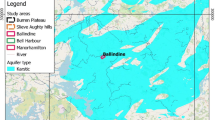Abstract
Dewatering operations often stop at mine closure. The ground water rebound can have undesirable consequences, which numerical models can help one understand and manage. However, classical modelling techniques are relatively unsuitable to these contexts. While spatially distributed and physically based models suffer difficulties due to the lack of data and the complexity of geological and hydrogeological conditions, black-box models are too simple to deal with the problems effectively. A new modelling method is proposed to simulate ground water environments in which water flows through mined (exploited) and unmined (unexploited) areas. Exploited zones are simulated using a group of mixing cells possibly interconnected by pipes. Unexploited zones are simultaneously simulated using classical finite elements. This combined approach allows explicit calculation of ground water flows around the mine and mean water levels in the exploited zones. Water exchanges between exploited zones and unexploited zones are simulated in the model using specifically defined internal boundary conditions. The method is tested on synthetic cases of increasing complexity, and first results from a real case study are presented.














Similar content being viewed by others
References
Adams R, Younger PL (1997) Simulation of ground water rebound in abandoned mines using physically based modelling approach. In: Proceedings of the 6th international mine water association congress, Bled, pp 353–362
Barchy L, Marion J-M (2000) Carte géologique de Wallonie et notice explicative—Dalhem-Herve 42/3-4. Namur, Ministère de la Région Wallonne, Direction Générale des Ressources Naturelles et de l’Environnement
Boyaud C, Therrien R (2004) Numerical modelling of mine water rebound in Saizerais, northeastern France. In: Proceedings of the 15th international conference on computational method in water resources, Elsevier Science, Amsterdam, pp 979–989
Brouyère S (2001) Etude et modélisation du piégeage de solutés en milieu variablement saturé. Faculté des Sciences Appliquées, University of Liège, Liège, 572 pp
Brouyère S, Carabin G, Dassargues A (2004) Climate change impacts on ground water resources: modelled deficits in a chalky aquifer, Geer basin, Belgium. Hydrogeol J 12:123–134
Carabin G, Dassargues A (1999) Modeling ground water with ocean and river interaction. Water Resour Res 35(8):2347–2538
Dingelstadt C, Drevet J-P, Veschkens M, Flamion B (2007). Etude des conséquences de l’après-mine en particulier sur la gestion des eaux souterraines et des risques—Mission 2006. Inst Scientifique de Service Public, Liege, 67 pp
Eckart M, Kories H, Rengers R, Unland W (2004) Application of a numerical model to facilitate mine water management in large coalfields in Germany. In: Proceedings of the mine water 2004—process, policy and progress, Newcastle upon Tyne, pp 209–218
Rapantova N, Grmela A, Vojtek D, Halir J, Michalek B (2007) Ground water flow modelling applications in mining hydrogeology. Mine Water Environ 26:264–270
Ruthy I, Dassargues A (2008) Carte hydrogéologique de Wallonie et notice explicative—Dalhem-Herve 42/3-4. Namur, Ministère de la Région Wallonne, Direction Générale des Ressources Naturelles et de l’Environnement
Sherwood JM, Younger PL (1994) Modelling ground water rebound after coalfield closure: an example from County Durham. In: Proceedings of the 5th international mine water association congress, University of Nottingham, Nottingham, vol 2, pp 769–777
Sherwood JM, Younger PL (1997) Modelling ground water rebound after coalfield closure. In: Proceedings of the 28th congress of the international association of hydrogeologists, Nottingham, UK, AA Balkema, Rotterdam, vol 1, pp 165–170
Younger PL, Banwart SA, Hedin SH (2002) Mine water: hydrology, pollution, remediation. Kluwer, London, p 464
Acknowledgments
The authors thank the Walloon Region, which has financially supported this project, together with the “Institut Scientifique de Service Public” (ISSeP) and the “Association Intercommunale pour le Démergement et l’Epuration” (AIDE). Conceptual and numerical developments of the HFEMC approach have also been performed in the framework of the Interuniversity Attraction Pole TIMOTHY (IAP Research Project P6/13), which is funded by the Belgian Federal Science Policy Office (BELSPO) and the European Integrated Project AquaTerra (GOCE 505428) with funding from the Community’s Sixth Framework Programme.
Author information
Authors and Affiliations
Corresponding author
Rights and permissions
About this article
Cite this article
Brouyère, S., Orban, P., Wildemeersch, S. et al. The Hybrid Finite Element Mixing Cell Method: A New Flexible Method for Modelling Mine Ground Water Problems. Mine Water Environ 28, 102–114 (2009). https://doi.org/10.1007/s10230-009-0069-5
Received:
Accepted:
Published:
Issue Date:
DOI: https://doi.org/10.1007/s10230-009-0069-5




